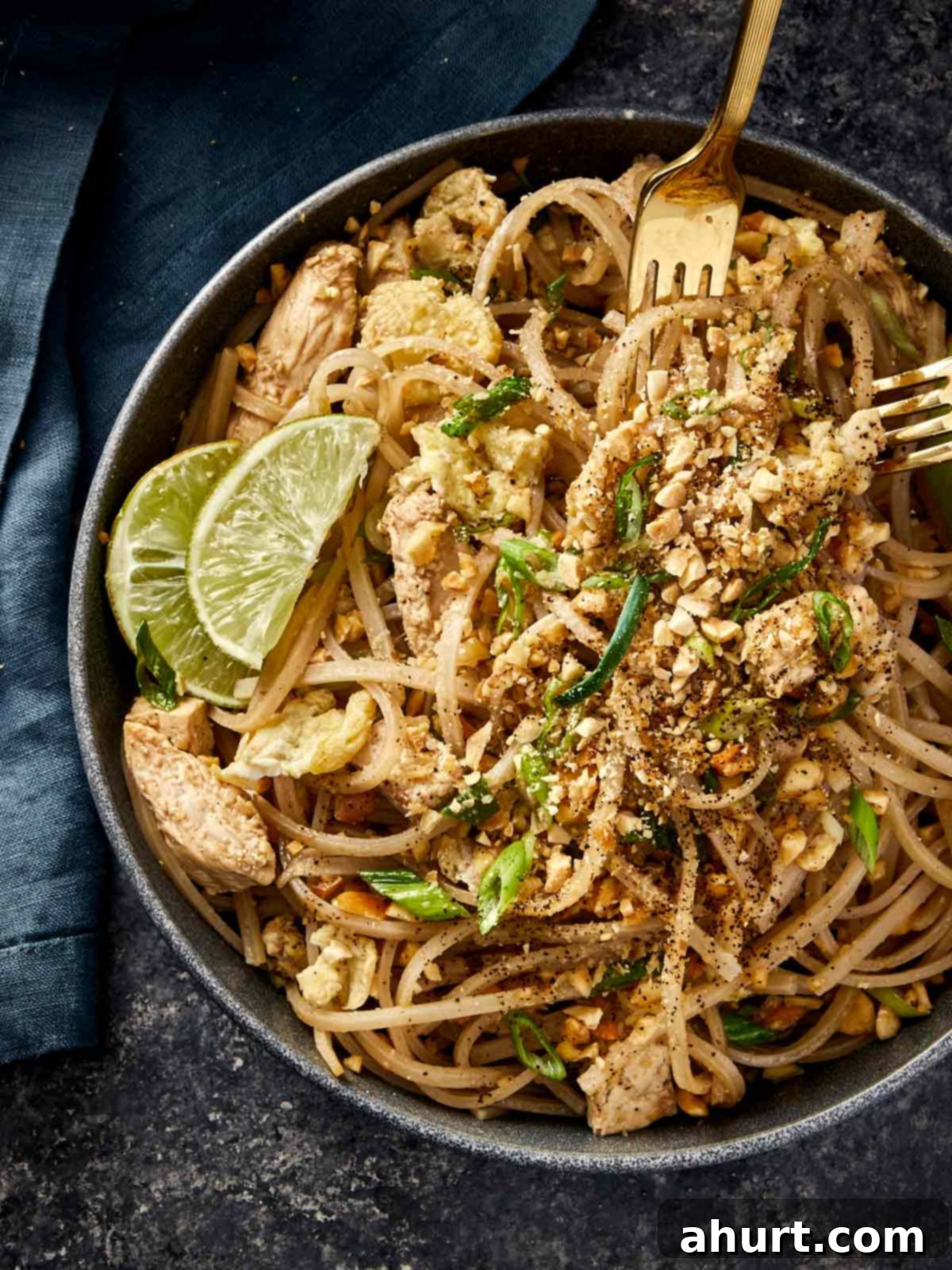Mastering Authentic Pad Thai: Your Guide to a Flavorful Chicken and Tofu Stir-Fry at Home
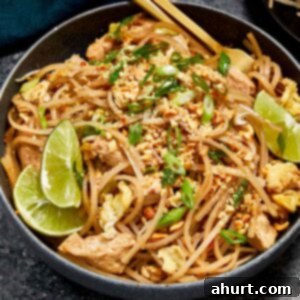
Pin
Authentic Pad Thai with Chicken & Tofu: A Quick & Flavorful Recipe
Ingredients
- 7 oz flat rice noodles
- 2 tbsp tamarind puree
- 3 tbsp brown sugar
- 3 ½ tbsp fish sauce
- 2 ½ tbsp oyster sauce
- 5 tbsp vegetable oil
- 3 ½ garlic cloves minced
- 1 yellow onion thinly sliced
- 7 oz chicken breast finely minced or ground
- 3 large eggs lightly whisked
- 2 ½ cups fresh bean sprouts
- 1 cup firm tofu pressed and cut into small cubes
- ½ cup green onions sliced, plus extra for garnish
- ½ cup roasted peanuts chopped, plus extra for serving
- lime wedges for serving
- ground chili flakes optional, for spice
- extra fresh bean sprouts for serving
Instructions
-
Begin by preparing your rice noodles. Place them in a large bowl, then carefully pour boiling water over them until fully submerged. Allow them to soak for exactly 5 minutes until pliable but still slightly firm. Immediately drain and rinse under cold water to stop the cooking process and prevent sticking. Set aside.
-
In a separate small bowl, combine the tamarind puree, brown sugar, fish sauce, and oyster sauce. Whisk well until the sugar has dissolved and the sauce is thoroughly mixed. This is your flavorful Pad Thai sauce.
-
Heat the vegetable oil in a large wok or a heavy-bottomed skillet over high heat until it just begins to smoke. Add the minced garlic and sliced onion, stir-frying rapidly for about 30 seconds until fragrant and slightly softened.
-
Add the minced chicken breast to the wok. Cook for approximately 2 minutes, breaking it up with your spatula, until it is mostly cooked through and no longer pink.
-
Push the cooked chicken and aromatics to one side of the wok, creating an empty space. Pour the lightly whisked eggs into this clear area. Scramble the eggs quickly until they are just set, then mix them into the chicken mixture.
-
Introduce the fresh bean sprouts, cubed tofu, prepared rice noodles, and the Pad Thai sauce to the wok. Using tongs, gently lift and toss all the ingredients for 1-2 minutes until the noodles are evenly coated with the sauce and everything is well combined and heated through. Avoid stirring too vigorously to prevent breaking the noodles.
-
Finally, add the sliced green onions and half of the chopped roasted peanuts. Give the mixture a final quick toss to incorporate them, then immediately remove the wok from the heat to prevent overcooking the noodles or vegetables.
-
Serve the Pad Thai immediately in individual bowls. Garnish generously with the remaining chopped peanuts, fresh lime wedges for a burst of citrus, and extra bean sprouts for added crunch. If you enjoy a spicy kick, sprinkle with ground chili flakes to taste. Enjoy!
Notes
Follow these expert tips to ensure your homemade Pad Thai turns out absolutely perfect every time:
- Noodle Perfection. It’s crucial not to over-soak your rice noodles. They should be flexible and pliable but still possess a slight firmness, as they will continue to cook and soften in the hot wok. Over-soaked noodles will become mushy and break apart easily.
- Maintain High Heat. Pad Thai thrives on intense heat. Cooking in a properly heated wok or skillet ensures a quick sear on your ingredients, developing a beautiful caramelized flavor and that signature glossy finish on the noodles. Don’t be timid with the flame!
- Achieve Flavor Balance. Before adding your sauce to the noodles, always give it a quick taste. Pad Thai is all about balancing sweet, sour, and savory. Adjust the sauce to your preference: add a little more brown sugar for extra sweetness, a dash more fish sauce for umami, or a squeeze of fresh lime juice for an enhanced tang.
- Toss, Don’t Stir. When combining the noodles and sauce, use a gentle lifting and turning motion with your tongs. This technique ensures that the noodles are coated evenly without breaking them, preserving their delightful texture.
- Customize Your Dish. This recipe is incredibly versatile! Feel free to swap chicken for succulent shrimp or a mix of both. For a delicious vegetarian version, omit the chicken and add extra tofu, mushrooms, or your favorite stir-fry vegetables. For those who love a fiery kick, incorporate crushed chili flakes or fresh bird’s eye chilies.
Nutrition
Nutrition information is automatically calculated, so should only be used as an approximation.
There’s an undeniable magic about a plate of Pad Thai that satisfies every craving. The springy rice noodles, perfectly tangled with savory chicken, tender tofu, vibrant crunchy bean sprouts, and a generous sprinkle of roasted peanuts—all swimming in that signature sweet, tangy, and salty sauce that defines authentic Thai cuisine. It’s a dish that’s both comforting and exhilarating, a true culinary masterpiece.
Originating from Thailand, Pad Thai has captured hearts worldwide, becoming a staple on menus from bustling street food stalls to upscale restaurants. While it might seem complex, creating this iconic stir-fry in your own kitchen is surprisingly straightforward. Add a fresh squeeze of lime for brightness and a dash of chili if you crave some heat, and you’ve got a restaurant-quality meal without the takeout wait. This homemade Pad Thai with chicken and tofu is quick, easy, and bursting with authentic flavors—a delightful weeknight dinner you’ll want to revisit time and time again.
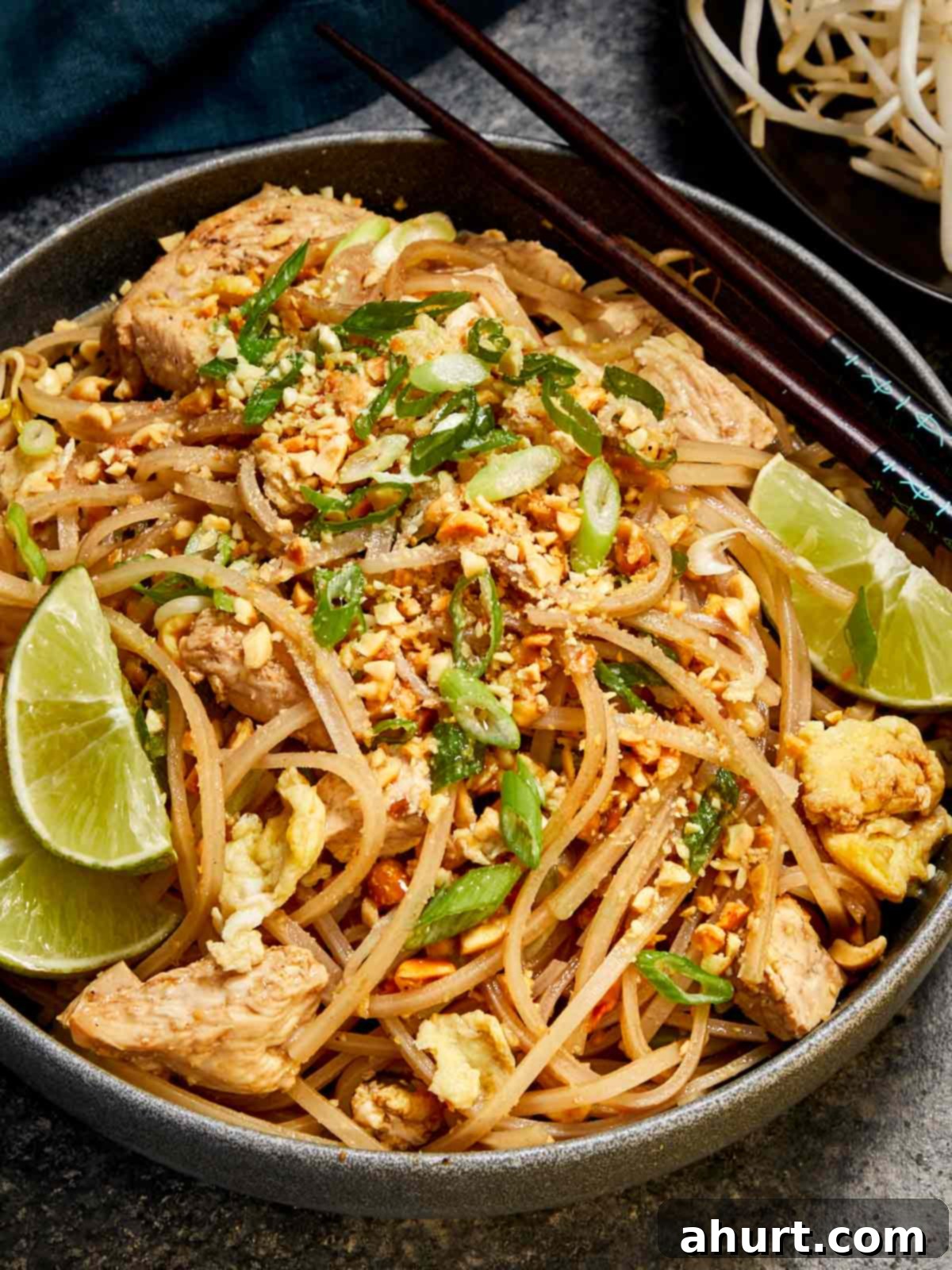
The Art of Balance in a Bowl
What truly sets Pad Thai apart, and what I cherish most about this particular recipe, is its exquisite balance of flavors. Thai cuisine is celebrated for its harmonious blend of sweet, sour, salty, bitter, and spicy elements, and Pad Thai perfectly embodies this philosophy. That delightful tang from the tamarind puree, the profound salty depth from the fish and oyster sauces, and just the right touch of sweetness from the brown sugar all come together to create an unforgettable taste experience. It’s the same kind of nuanced harmony I strive for in dishes like my Thai Chicken Satay, where every component plays a vital role.
Beyond flavor, the textural interplay in Pad Thai is equally captivating. You’ve got the satisfying chewiness of the noodles, the tender juiciness of the chicken, the soft creaminess of the tofu, and the invigorating crunch of fresh bean sprouts and peanuts. Each forkful offers a dynamic combination of textures that keeps every bite exciting and delicious. It’s a culinary tapestry, much like the rich layers of flavor and texture I build in my Crispy Slow Cooker Carnitas, where simple ingredients transform into something truly extraordinary. A final squeeze of fresh lime, a sprinkle of extra peanuts, and perhaps a hint of chili elevate the dish, making it utterly addictive.
Essential Ingredients for Authentic Pad Thai
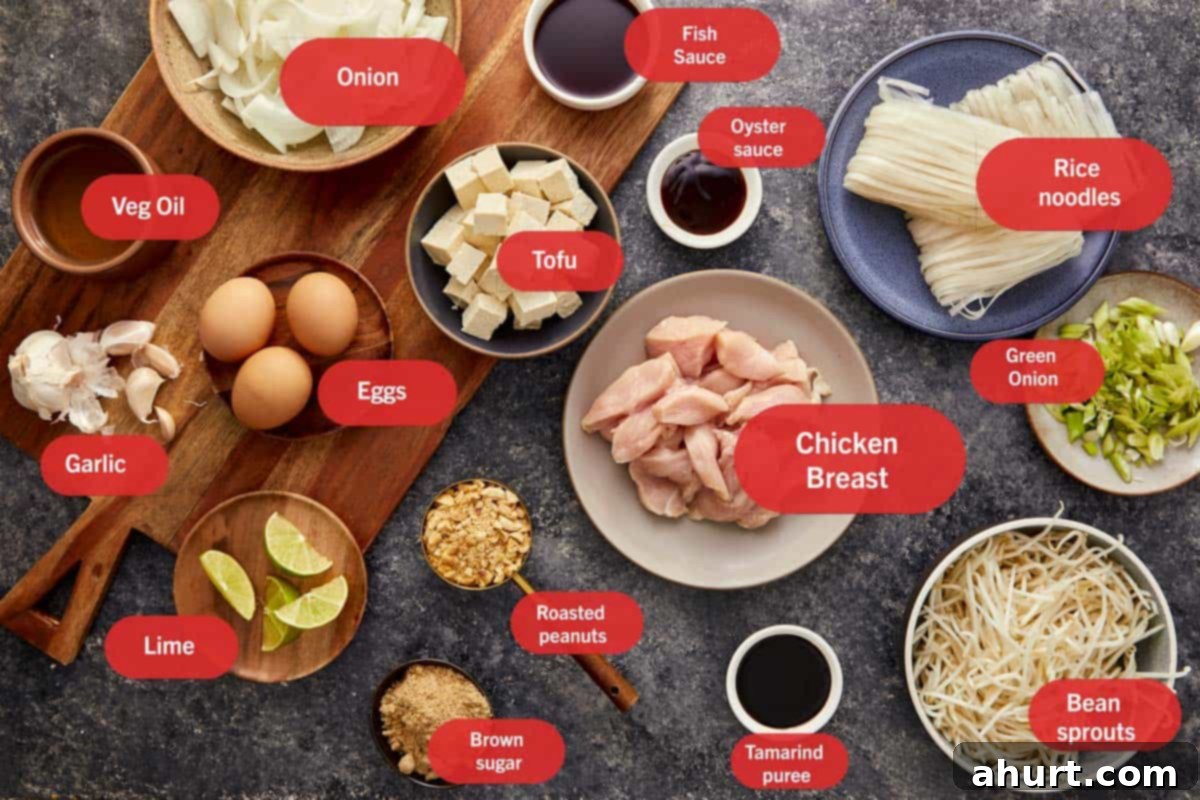
Creating truly delicious Pad Thai doesn’t rely on overly complicated techniques; rather, it hinges on bringing together a few key ingredients that, when combined, create a symphony of flavors and textures you’ll endlessly crave. These are the stars that make this authentic Thai stir-fry shine:
- Flat Rice Noodles: These are the heart and soul of Pad Thai. Their broad, flat shape and wonderfully chewy texture are perfect for soaking up the rich sauce. Choose a medium-width rice noodle, as thin vermicelli can become mushy, and extra-wide ones can be harder to manage. Proper preparation (soaking, not boiling) is key to their success.
- Tamarind Purée: This is the secret to Pad Thai’s distinctive fruity tang. Derived from the pod of the tamarind tree, it offers a complex sourness that can’t be replicated by lime juice alone. It provides the essential backbone for the iconic sweet and sour profile of the sauce. Look for it in Asian markets or the international aisle of larger supermarkets.
- Fish Sauce & Oyster Sauce: These two ingredients are fundamental to Thai cooking, delivering a profound depth of savory, umami flavor. Fish sauce provides the salty, savory foundation with a subtle “funk” that is surprisingly delicious when cooked. Oyster sauce adds a thicker consistency and a slightly sweeter, richer umami kick, contributing to the glossy sheen that coats the noodles. Don’t skip these for authentic taste!
- Chicken & Tofu: This recipe uses both lean chicken breast and firm tofu, offering a delightful contrast in textures and flavors. The minced chicken cooks quickly and provides tender, juicy bites, while the pressed and cubed tofu adds a soft, slightly creamy element that absorbs the sauce beautifully. Together, they make the dish hearty and satisfying.
- Bean Sprouts & Peanuts: These fresh and crunchy additions are non-negotiable for the complete Pad Thai experience. Fresh bean sprouts provide a refreshing crispness and a hint of sweetness, while roasted, chopped peanuts deliver a wonderful nutty flavor and a satisfying textural contrast. These garnishes add essential layers that keep every forkful exciting.
Note: For the exact quantities and detailed measurements of all ingredients, please refer to the comprehensive Recipe Card above.
Cooking Method: Wok This Way to Perfect Pad Thai
Achieving restaurant-quality Pad Thai at home is all about high heat, quick movements, and layering flavors. Here’s a detailed breakdown of how to bring this vibrant dish to life:
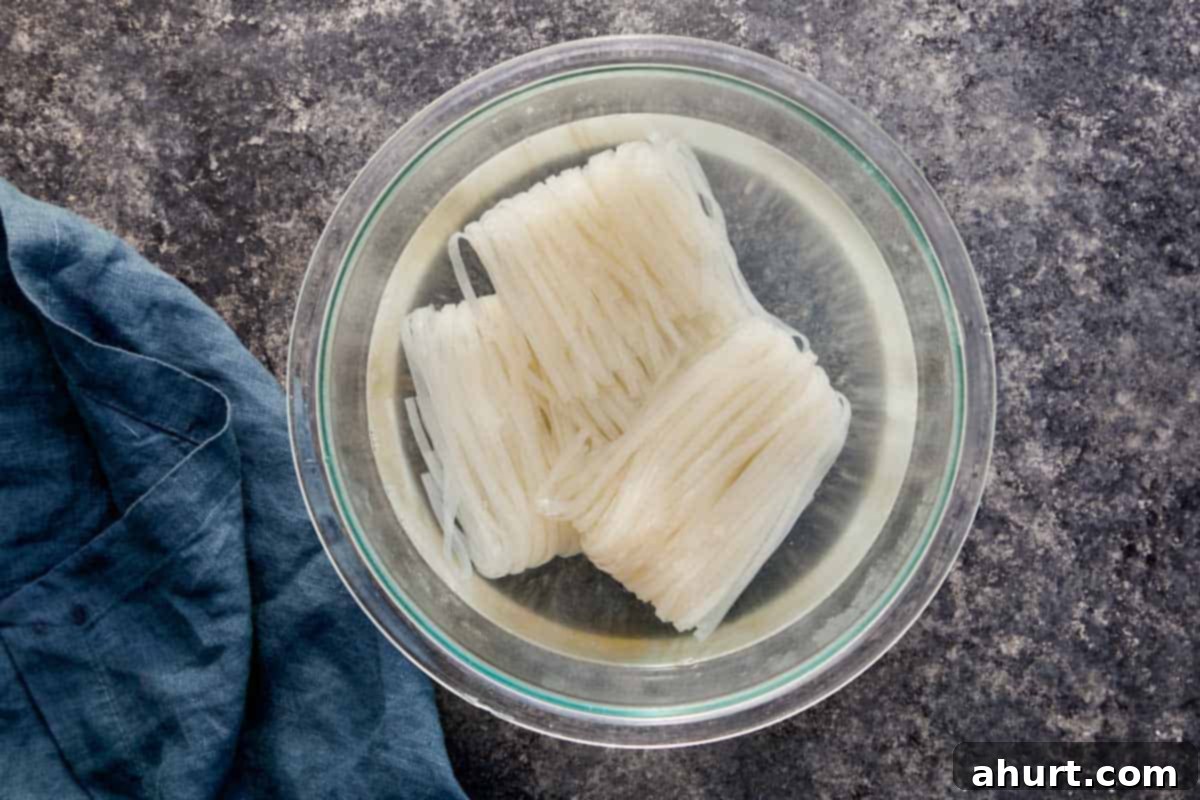
- Prepare the Noodles. Place your flat rice noodles in a heatproof bowl and cover them completely with boiling water. Let them soak for exactly 5 minutes until they are tender but still retain a slight bite. Immediately drain and rinse them under cold water to prevent them from becoming sticky and overcooked.
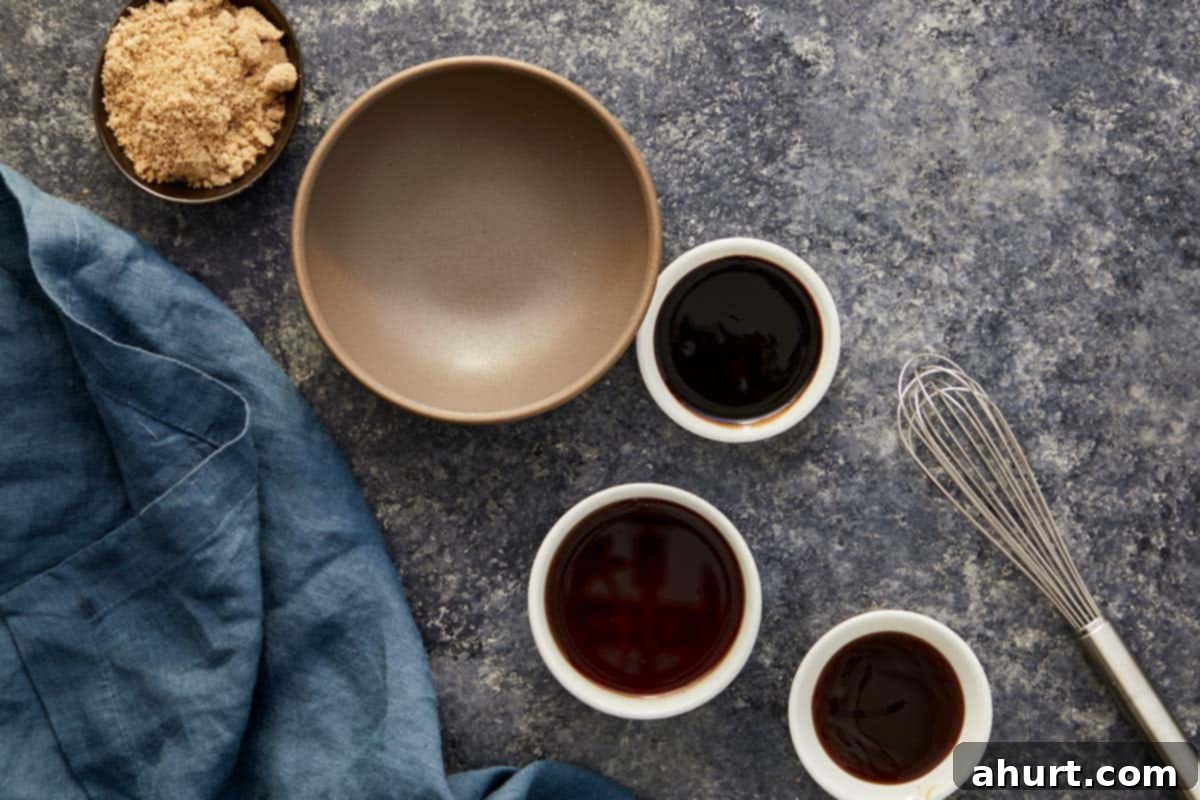
- Whisk the Sauce. In a small bowl, combine the tamarind puree, brown sugar, fish sauce, and oyster sauce. Whisk vigorously until the brown sugar has fully dissolved and all ingredients are smoothly integrated. This balanced sauce is the heart of your Pad Thai.
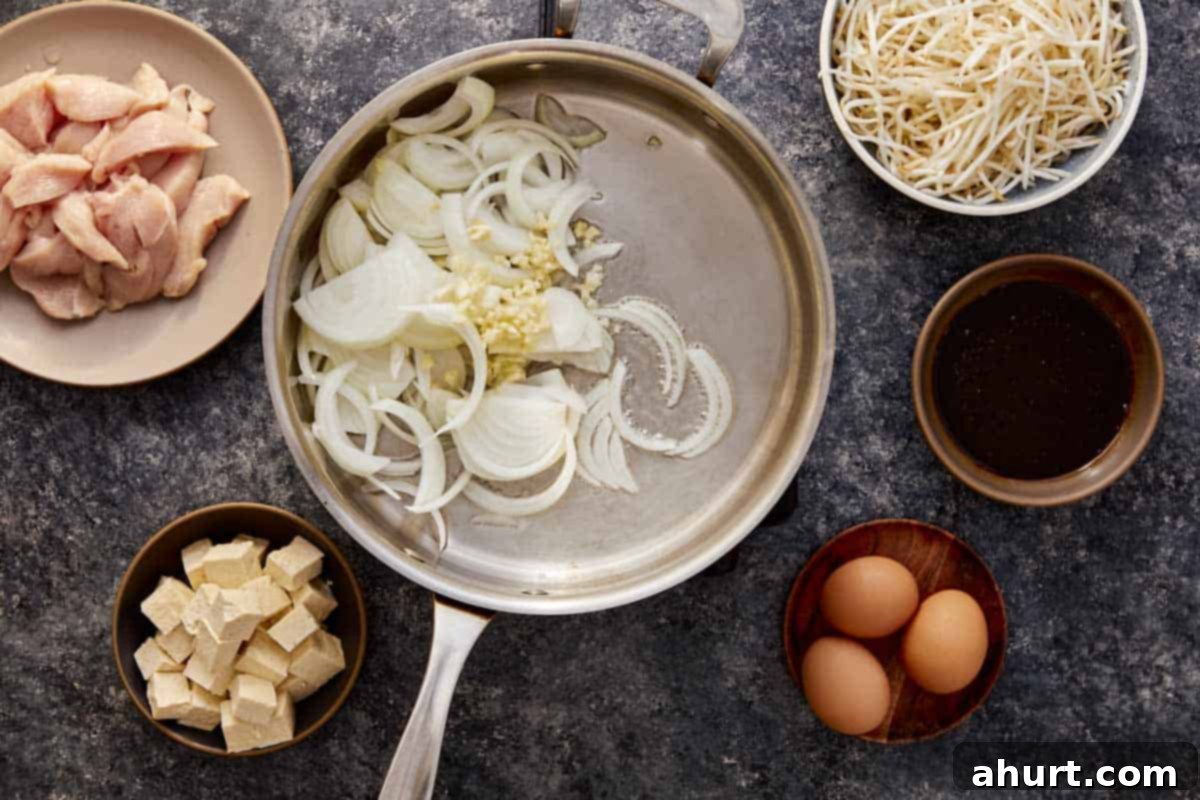
- Sauté Aromatics. Heat the vegetable oil in a large wok or a spacious skillet over high heat until it shimmer. Add the minced garlic and thinly sliced onion, stir-frying for about 30 seconds until they become fragrant and slightly translucent. Be careful not to burn the garlic.
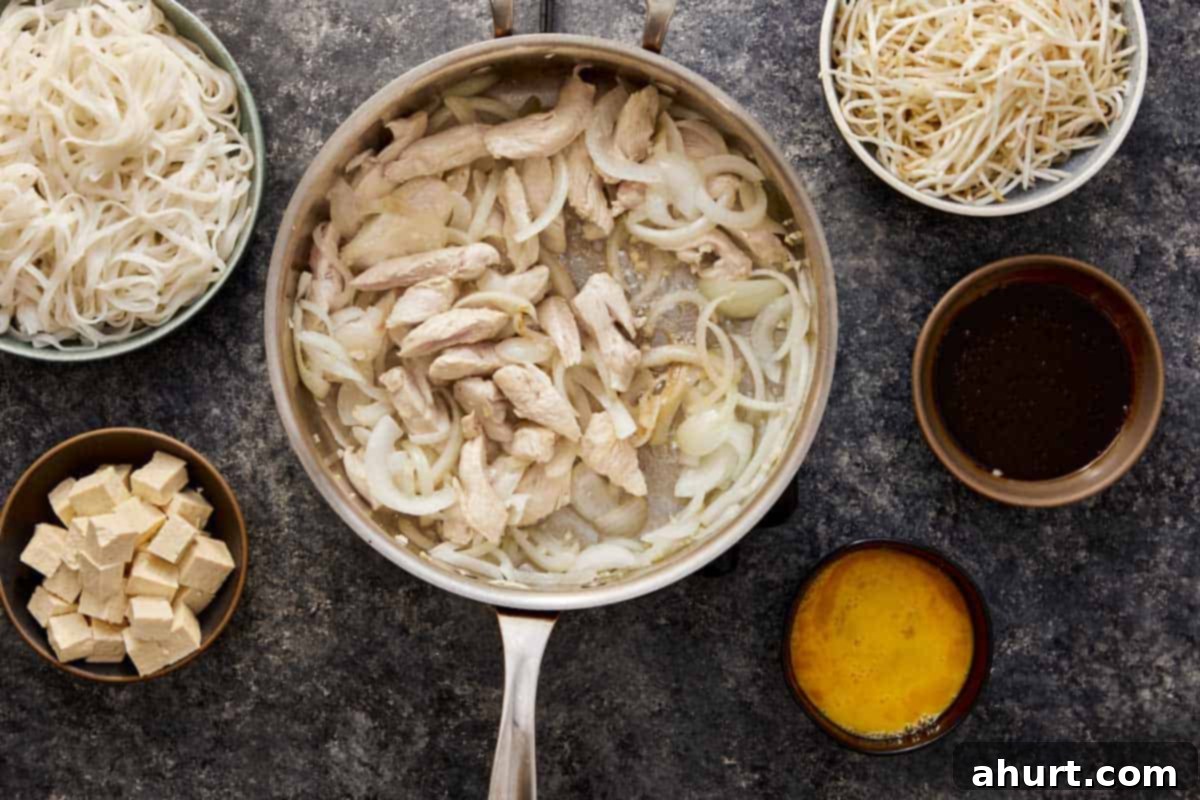
- Cook the Chicken. Add the minced chicken breast to the wok. Stir-fry for approximately 2 minutes, breaking up any clumps, until the chicken is mostly cooked through and lightly golden.
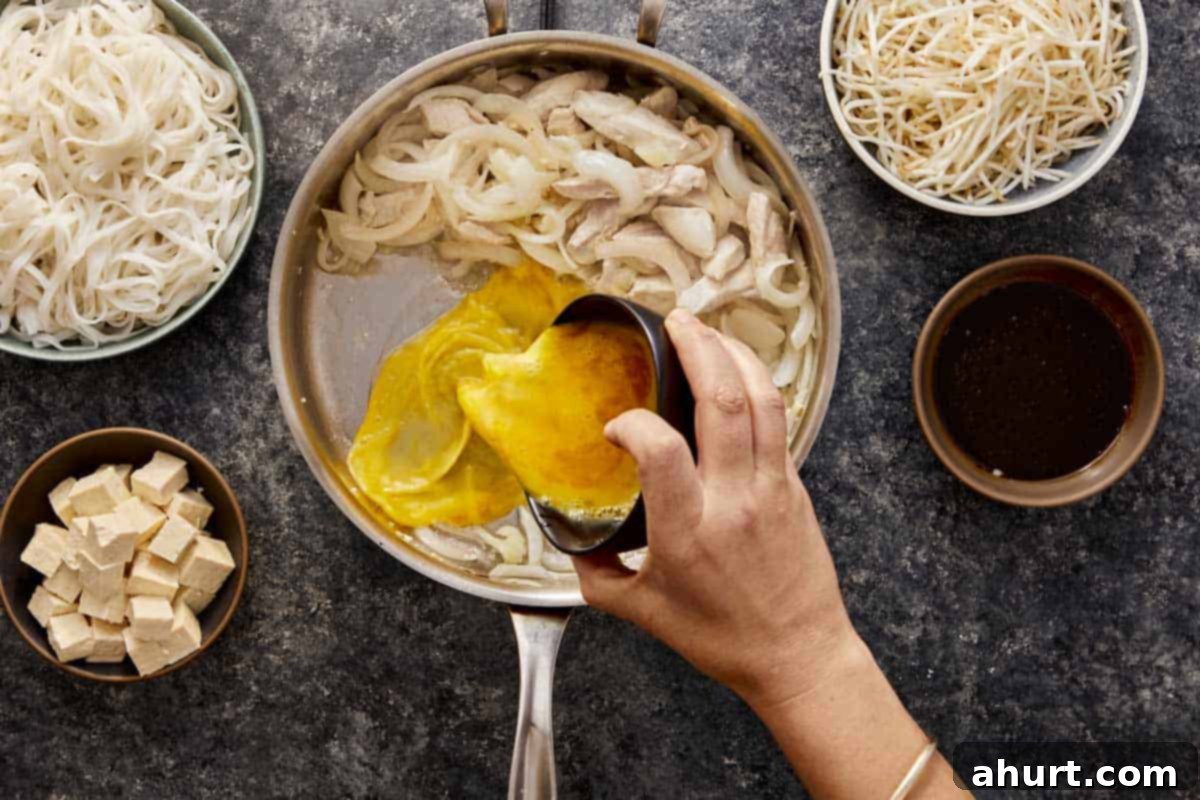
- Incorporate Eggs. Push the chicken mixture to one side of the wok to create an open space. Pour the lightly whisked eggs into this space. Quickly scramble the eggs until they are just set but still moist, then mix them gently with the chicken and aromatics.
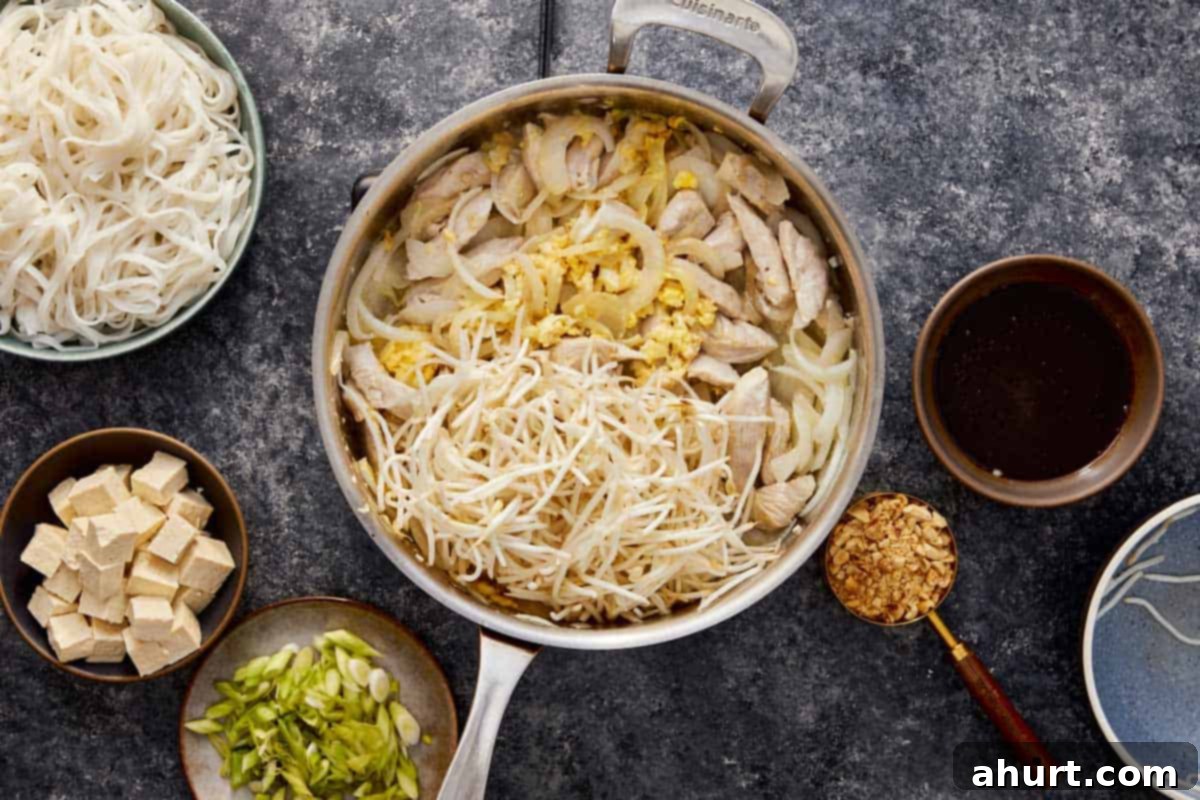
- Combine All Elements. Add the fresh bean sprouts, cubed tofu, the pre-soaked rice noodles, and your prepared Pad Thai sauce to the wok. Using tongs, gently lift and toss all the ingredients continuously for 1 to 2 minutes. Ensure the noodles are thoroughly coated with the glossy sauce and everything is heated through.
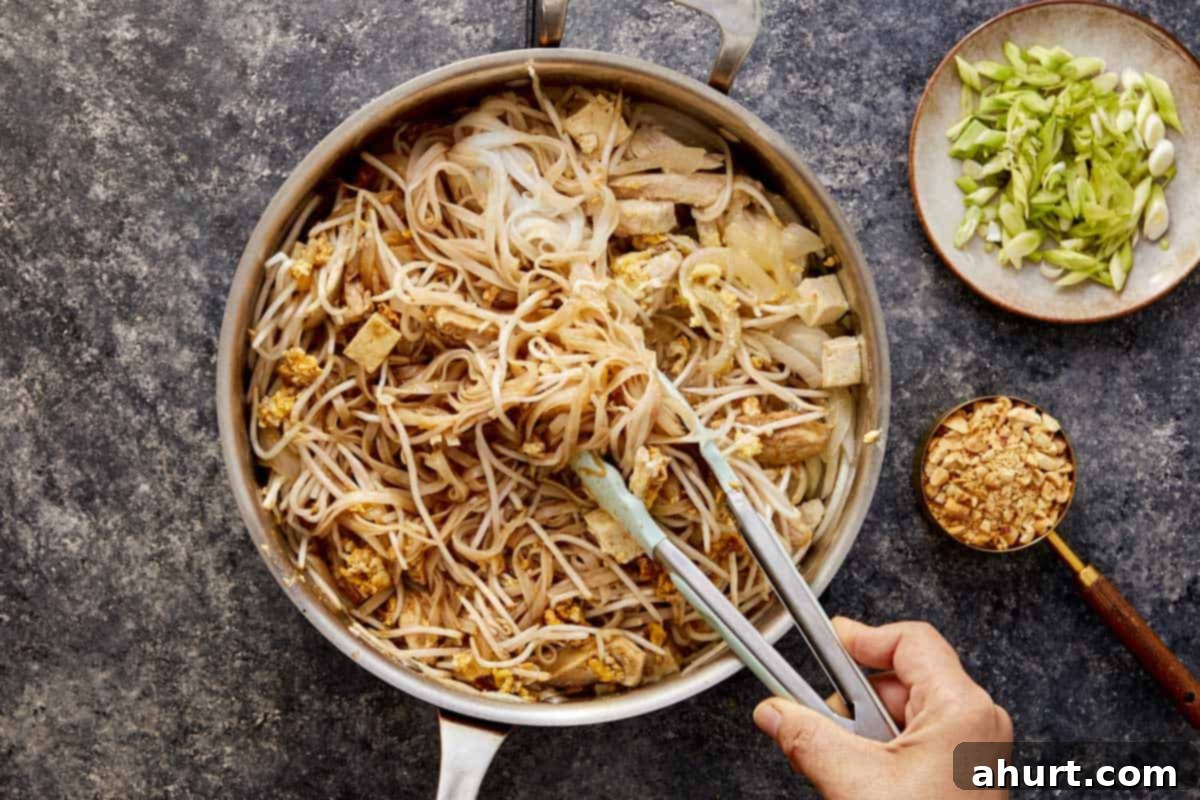
- Final Toss. Stir in the sliced green onions and half of the chopped roasted peanuts. Give the Pad Thai one last quick toss to combine, then immediately remove the wok from the heat. This prevents the vegetables from becoming limp and the noodles from overcooking.
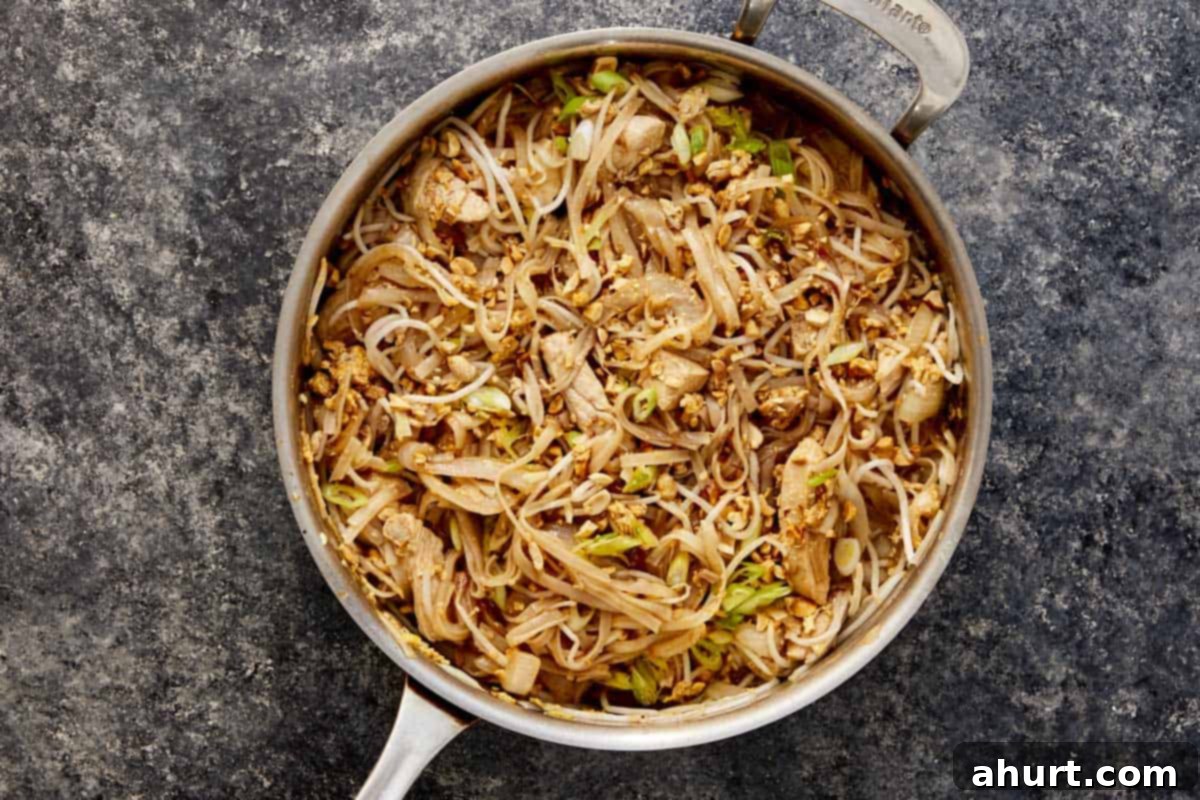
- Serve Immediately. Divide the hot Pad Thai among serving bowls. Garnish each portion generously with the remaining chopped peanuts, fresh lime wedges for a zesty finish, and extra fresh bean sprouts for an added crisp textural contrast. For those who enjoy a little heat, a sprinkle of ground chili flakes is the perfect touch.
Pro Tip: If you notice your noodles starting to clump together during the stir-frying process, don’t panic! Simply splash in 1–2 tablespoons of water (or chicken broth) and continue to lift-and-turn them with tongs. This will help separate them without breaking their delicate structure.
For a visual guide to each step and to watch this flavorful dish come together, check out the detailed video in the See It In Action section below. It’s a fantastic way to ensure you’re mastering every technique for perfect Pad Thai.
If you’re looking to expand your culinary repertoire with more Asian-inspired street food flavors or complementary dishes, I’ve got a few favorites that are sure to delight. My quick, low-carb Cauliflower Fried Rice offers all the savory goodness of traditional fried rice but without the heaviness, making it a perfect lighter alternative. Feeling a little adventurous? Try my fluffy, flavor-bomb Bao Buns stuffed with juicy pulled pork and a rich black garlic mayo—they are the ultimate handheld treat and incredibly satisfying. For a straightforward weeknight stir-fry, my Honey Soy Chicken Stir-Fry is a go-to, offering sweet, savory notes and plenty of crisp, fresh vegetables. And if you’re in the mood for something pressed, melty, and utterly comforting, my loaded Cuban Sandwich, packed with slow-roasted pork, ham, tangy pickles, and Swiss cheese, is pure bliss. It’s truly hard to pick a favorite when they all offer such incredible flavors!
Frequently Asked Questions About Pad Thai
Absolutely! This Pad Thai recipe is highly adaptable. To make it vegetarian, simply omit the chicken and use extra firm tofu. You can also add more of your favorite vegetables like bell peppers, mushrooms, or carrots. For a vegan version, ensure you use a vegan fish sauce substitute and omit the oyster sauce and eggs. There are excellent plant-based oyster sauce alternatives available that will maintain the umami depth.
While tamarind puree provides the most authentic flavor, don’t let its absence stop you. A good substitute can be created using a mix of fresh lime juice and a touch of rice vinegar, combined with a pinch more brown sugar to balance the tartness. This will mimic the sweet and sour profile that the dish needs, though the depth of flavor will be slightly different.
Yes, absolutely! Shrimp is a very traditional protein in Pad Thai and makes an excellent substitution for chicken, or you can even use a combination of both. Shrimp cooks very quickly, typically in just 2-3 minutes until pink and opaque, so be sure to add it towards the end of the cooking process to avoid overcooking and making it rubbery.
The key to preventing clumpy noodles is proper preparation and quick wok technique. Ensure your noodles are rinsed thoroughly under cold water after soaking to remove excess starch. When they go into the wok, keep the heat high and toss them quickly and continuously using tongs. If they do start to stick or clump, a splash (1-2 tablespoons) of water or chicken broth can help loosen them. Always lift and turn with tongs rather than stirring vigorously, which can break the noodles.
The base Pad Thai recipe itself is not inherently spicy; its primary flavor profile is sweet, sour, and savory. The spice level is entirely customizable to your preference. If you enjoy heat, you can easily sprinkle in ground chili flakes or add fresh sliced bird’s eye chilies (Thai chilies) when serving. You can also incorporate a small amount of chili paste into the sauce if you prefer a spicier overall flavor.
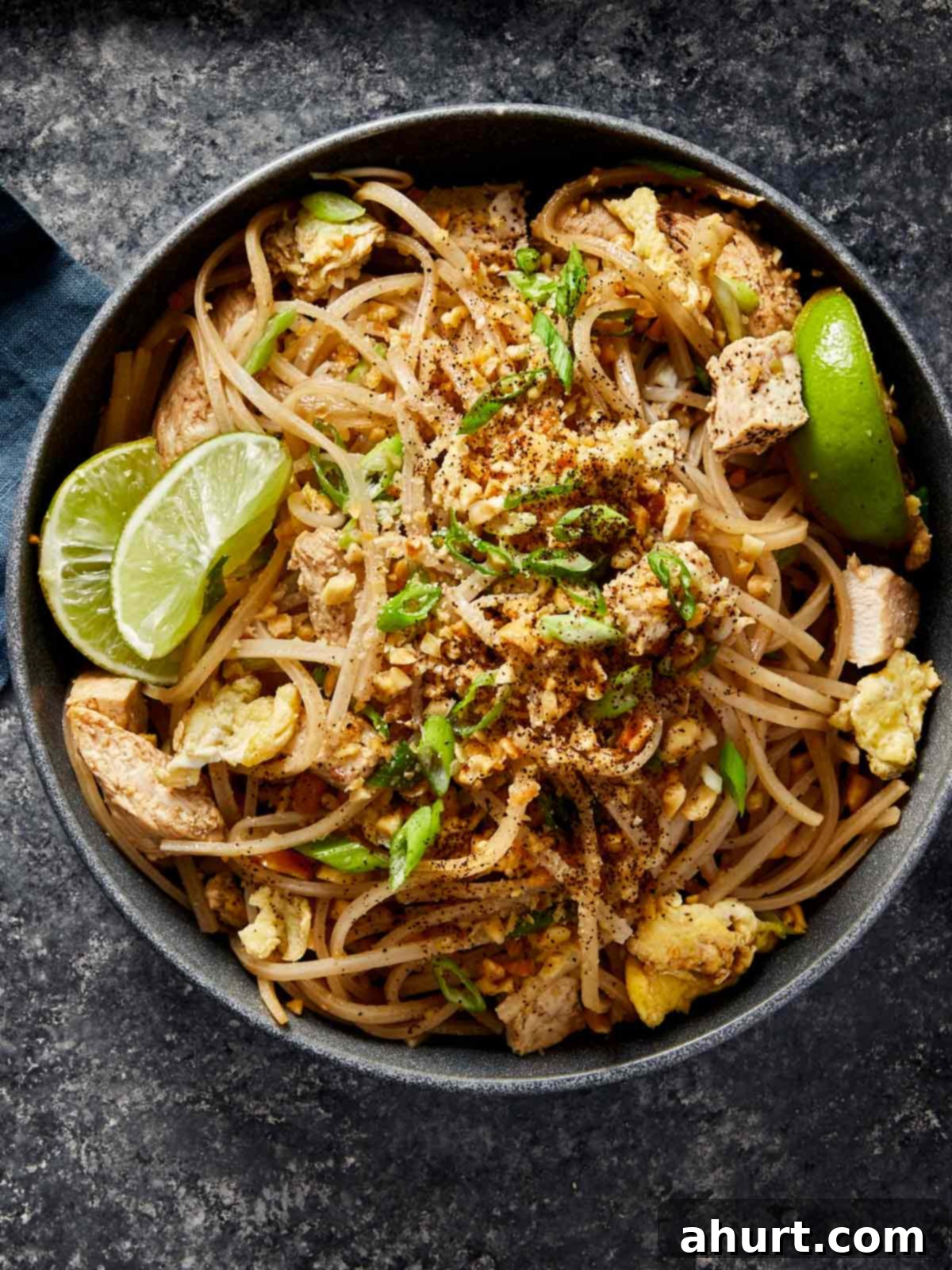
See It In Action: Step-By-Step Video Guide
Watching a recipe come to life can be incredibly helpful, especially for a dynamic dish like Pad Thai. This step-by-step video guide walks you through each stage of the cooking process, from preparing your ingredients to the final stir-fry, ensuring you feel confident and ready to create your own authentic masterpiece. You’ll see exactly how to manage the heat, toss the noodles, and achieve that perfect glossy finish.
We hope this comprehensive guide inspires you to whip up a batch of homemade Pad Thai tonight. With its vibrant flavors, exciting textures, and simple preparation, it’s a dish that promises to delight your taste buds and bring the taste of Thailand right into your home. Don’t hesitate to experiment with the “Tips & Twists” and customize it to your liking. Happy cooking!
